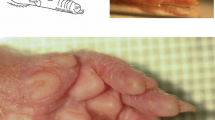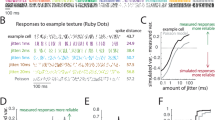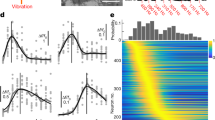Summary
The present experiments were designed to characterize the discharge patterns of single cortical neurones within the cutaneous representation of the hand in postcentral cortex (areas 3b and 1) in awake monkeys during the performance of an active tactile discrimination task. The task consisted of making a single scanning movement over a surface (first half smooth; second half smooth or rough); the texture encountered over the second half of the surface was indicated by the animal, respectively, pushing or pulling a lever. Unitary discharge was recorded from 118 cells receiving input from the hand or distal forearm of two monkeys. Units with cutaneous fields on the digit tips in contact with the surfaces to be discriminated showed an increase in discharge (58%), a decrease in discharge (11%) or no change (31%) during the task. Units with cutaneous fields not in contact with the discriminanda were much more likely to show decreased discharge during the task (25%), suggesting that there is some selection of cutaneous inputs in this task. Cutaneous units in areas 3b and 1 were equally likely to signal differences in texture (respectively, 18% and 26% of those with digital receptive fields (RFs)) and most of the texture-related units (78%) had a large RF, spanning several digits. The discharge patterns of single texture-related cells did not reliably signal whether or not the animal successfully discriminated the surfaces: unitary responses were occasionally absent even though the animal correctly identified the surface or they were present when an incorrect response was made. This observation suggested that information derived from a population of cells is required for the performance of the task, since no single cell's discharge contained sufficient information upon which the animal could base its behavioural response. A group of cells with digital RFs (24% of area 3b cells and 15 % of area 1 units) were classified as movement-related. Their discharge signalled precisely the onset and/or end of movement, and they were generally insensitive to the texture of the surfaces scanned. Such cells may serve as an independent source of information for primary somatosensory cortex related to the physical parameters of movement. Most cells with digital RFs were more responsive during active tactile discrimination than during passive movement of the digits over the surfaces (monkey no longer required to discriminate the surface texture). For area 3b units, peripheral factors (RF orientation, speed of movement) were likely responsible for this observation. For area 1 units, the situation was more complex: 26% of the area 1 units were only active during the active behavioural task, suggesting that such units may signal peripheral events, but in a context-dependent manner. This may be related to attention, although other factors were not ruled out in the present experiments. Finally, the depth of modulation in the task was almost always less than that produced by classical RF testing, suggesting that the tactile inputs generated during exploratory movements are subject to gating controls, as has been shown for other types of movements.
Similar content being viewed by others
References
Ageranioti SA, Chapman CE (1988) Receptive field and discharge properties of primary somatosensory cortical units during active tactile discrimination. Abstr Soc Neurosci 14:509
Ageranioti SA, Chapman CE (1989) Gating of cutaneous inputs during an active tactile discrimination task versus passive receptive fields testing in the monkey. Abstr Soc Neurosci 15:314
Bushnell MC, Duncan GH, Dubner R, Jones RL, Maixner W (1985) Attentional influence on noxious and innocuous cutaneous heat detection in humans and monkeys. J Neurosci 5:1103–1110
Carli G, LaMotte RH, Mountcastle VB (1971) A comparison of sensory behavior and the activity of postcentral cortical neurons, observed simultaneously, elicited by oscillatory mechanical stimuli delivered to the contralateral hand in monkeys. Proc Int Union Physiol Sci 11:100
Carlson M (1981) Characteristics of sensory deficits following lesions of Brodmann's areas 1 and 2 in the postcentral gyrus of Macaca mulatta. Brain Res 204:424–430
Chapin JK, Woodward DJ (1981) Modulation of sensory responsiveness of single somatosensory cortical cells during movement and arousal behaviors. Exp Neurol 72:164–178
Chapin JK, Woodward DJ (1982) Somatic sensory transmission to the cortex during movement: gating of single cell responses to touch. Exp Neurol 78:654–669
Chapman CE (1987) Modulation of somatosensory cortical unitary responses during active tactile discrimination in the monkey. Abstr Soc Neurosci 13:473
Chapman CE, Bushnell MC, Miron D, Duncan GH, Lund JP (1987) Sensory perception during movement in man. Exp Brain Res 68:516–524
Chapman CE, Jiang W, Lamarre Y (1988) Modulation of lemniscal input during conditioned arm movements in the monkey. Exp Brain Res 72:316–334
Chapman CE, Spidalieri G, Lamarre Y (1986) Activity of dentate neurons during arm movements triggered by visual, auditory, and somesthetic stimuli in the monkey. J Neurophysiol 55:203–226
Coquery JM, Malcuit G, Coulmance M (1971) Altérations de la perception d'un stimulus somesthésique durant un mouvement volontaire. CR Soc Biol (Paris) 165:1946–1951
Coulter JD (1974) Sensory transmission through lemniscal pathway during voluntary movement in the cat. J Neurophysiol 37:831–845
Darian-Smith I (1984) The sense of touch: performance and peripheral neural processes. In: Darian-Smith I (eds) Handbook of physiology, Sect 1, Vol III. Sensory processes. American Physiological Society, Bethesda MD, pp 739–788
Darian-Smith I, Goodwin A, Sugitani M, Heywood J (1985) Scanning a textured surface with the fingers: events in sensorimotor cortex. Exp Brain Res Suppl 10:17–43
Darian-Smith I, Sugitani M, Heywood J, Karita K, Goodwin A (1982) Touching textured surfaces: cells in somatosensory cortex respond both to finger movement and to surface features. Science 218:906–909
Drew T, Rossignol S (1987) A kinematic and electromyographic study of cutaneous reflexes evoked from the forelimb of unrestrained walking cats. J Neurophysiol 57:1160–1184
Dyhre-Poulson P (1978) Perception of tactile stimuli before ballistic and during tracking movements. In: Gordon G (eds) Active touch. Pergamon Press, Oxford, pp 229–242
Dykes RW (1983) Parallel processing of somatosensory information: a theory. Brain Res Rev 6:47–115
Friedman DP, Murray EA, O'Neil JB, Mishkin M (1986) Cortical connections of the somatosensory fields of the lateral sulcus of macaques: evidence for a corticolimbic pathway for touch. J Comp Neurol 252:323–347
Garraghty PE, Florence SL, Kaas JH (1990) Ablations of areas 3a and 3b of monkey somatosensory cortex abolish cutaneous responsivity in area 1. Brain Res 528:165–169
Ghez C, Lenzi GL (1971) Modulation of sensory transmission in cat lemniscal system during voluntary movement. Pflügers Arch 323:273–278
Ghez C, Pisa M (1972) Inhibition of afferent transmission in cuneate nucleus during voluntary movement in the cat. Brain Res 40:145–151
Goodwin AW, Morley JW (1987) Sinusoidal movement of a grating across the monkey's fingerpad: representation of grating and movement features in afferent fiber responses. J Neurosci 7:2168–2180
Hyvärinen J, Poranen A (1978) Receptive field integration and submodality convergence in the hand area of the post-central gyrus of the alert monkey. J Physiol (Lond) 283:539–556
Hyvärinen J, Poranen A, Jokinen Y (1980) Influence of attentive behavior on neuronal responses to vibration in primary somatosensory cortex of the monkey. J Neurophysiol 43:870–882
Iwamura Y, Tanaka M (1978) Postcentral neurons in hand region of area 2: their possible role in the form discrimination of tactile objects. Brain Res 150:662–666
Iwamura Y, Tanaka M, Sakamoto M, Hikosaka O (1983a) Functional subdivisions representing different finger regions in area 3 of the first somatosensory cortex of the conscious monkey. Exp Brain Res 51:315–326
Iwamura Y, Tanaka M, Sakamoto M, Hikosaka O (1983b) Converging patterns of finger representation and complex response properties of neurons in area 1 of the first somatosensory cortex of the conscious monkey. Exp Brain Res 51:327–337
Jenkins WM, Merzenich MM, Ochs MT, Allard T, Guic-Robles E (1990) Functional reorganization of primary somatosensory cortex in adult owl monkeys after behaviorally controlled tactile stimulation. J Neurophysiol 63:82–104
Jiang W, Chapman CE, Lamarre Y (1990a) Modulation of somatosensory evoked responses in the primary somatosensory cortex produced by intracortical microstimulation of the motor cortex. Exp Brain Res 80:333–344
Jiang W, Chapman CE, Lamarre Y (1991) Modulation of the cutaneous responsiveness of neurones in the primary somatosensory cortex during conditioned arm movements in the monkey. Exp Brain Res 84:342–354
Jiang W, Lamarre Y, Chapman CE (1990b) Modulation of the cutaneous responsiveness of cutaneous cortical evoked potentials during isometric and isotonic contractions in the monkey. Brain Res 536:69–78
Jones EG, Coulter JD, Hendry SHC (1978) Intracortical connectivity of architectonic fields in the somatic sensory, motor and parietal cortex of monkeys. J Comp Neurol 181:291–348
Kaas JH, Nelson RJ, Sur M, Lin C-S, Merzenich MM (1979) Multiple representations of the body within the primary somatosensory cortex. Science 204:521–523
Lamarre Y, Chapman CE (1986) Comparative timing of neuronal discharge in cortical and cerebellar structures during a simple arm movement in the monkey. Exp Brain Res Suppl 15:14–27
Lamarre Y, Joffroy AF, Filion M, Bouchoux R (1970) A stereotaxic method for repeated sessions of central unit recording in the paralysed or moving animal. Rev Can Biol 29:371–376
Lamb GD (1983) Tactile discrimination of textured surfaces: psychophysical performance measurements in humans. J Physiol (Lond) 338:551–565
LaMotte RH, Srinivasan MA (1987a) Tactile discrimination of shape: responses of slowly adapting mechanoreceptive afferents to a step stroked across the monkey fingerpad. J Neurosci 7:1655–1671
LaMotte RH, Srinivasan MA (1987b) Tactile discrimination of shape: responses of rapidly adapting mechanoreceptive afferents to a step stroked across the monkey fingerpad. J Neurosci 7:1672–1681
McKenna TM, Whitsel BL, Dreyer DA (1982) Anterior parietal cortical topographic organization in macaque monkey: a reevaluation. J Neurophysiol 48:289–317
Moffett A, Ettlinger G, Morton HB, Piercey MF (1967) Tactile discrimination performance in the monkey: the effect of ablation of various subdivisions of posterior parietal cortex. Cortex 3:59–96
Murray EA, Mishkin M (1984) Relative contribution of SII and area 5 to tactile discrimination in monkeys. Behav Brain Res 11:67–84
Nelson RJ (1984) Responsiveness of monkey primary somatosensory cortical neurons to peripheral stimulation depends on “motor-set”. Brain Res 304:143–148
Nelson RJ (1988) Set related and premovement related activity of primary somatosensory cortical neurons depends upon stimulus modality and subsequent movement. Brain Res Bull 21:411–424
Paul RL, Merzenich M, Goodman H (1972) Representation of slowly and rapidly adapting cutaneous mechanoreceptors of the hand in Brodmann's areas 3 and 1 of macaca mulatta. Brain Res 36:229–249
Phillips JR, Johnson KO, Hsiao SS (1988) Spatial pattern representation and transformation in monkey somatosensory cortex. Proc Natl Acad Sci 85:1317–1321
Pons TP, Garraghty, PE, Cusick CG, Kaas JH (1985) The somatotopic organization of area 2 in macaque monkeys. J Comp Neurol 241:445–466
Posner MI, Snyder CRR, Davidson BJ (1980) Attention and the detection of signals. J Exp Psychol (Gen) 109:160–174
Post LJ, Chapman CE (1990) Effects of isometric contraction on the ability of human subjects to detect and discriminate vibrotactile stimuli. Can J Physiol Pharmacol 68:Axxvi
Post LJ, Chapman CE (1991) The effects of cross-modal manipulations of attention on the detection of vibrotactile stimuli in humans. Somatosens Motor Res 8:149–157
Powell TPS, Mountcastle VB (1959) Some aspects of the functional organization of the cortex of the postcentral gyrus of the monkey: a correlation of findings obtained in a single unit analysis with cytoarchitecture. Johns Hopkins Hosp Bull 105:108–131
Randolph M, Semmes J (1974) Behavioral consequences of selective subtotal ablations in the postcentral gyrus of macaca mulatta. Brain Res 70:5–70
Recanzone GH, Jenkins WM, Hradek GT, Schreiner CE, Graiski KA, Merzenich MM (1989) Frequency discrimination training alters topographical representations and distributed temporal response properties of neurons in SI cortex of adult owl monkeys. Abstr Soc Neurosci 15:1223
Sinclair R, Burton H (1988) Responses from area 3b of somatosensory cortex to textured surfaces during active touch in primate. Somatosens Res 5:283–310
Sinclair R, Burton H (1989) Responses from primary somatosensory cortex in m. mulatta during active discrimination of textured surfaces. Abstr Soc Neurosci 15:659
Soso MF, Fetz EE (1980) Responses of identified cells in postcentral cortex of awake monkeys during comparable active and passive joint movements. J Neurophysiol 43:1090–1110
Stein J (1978) Effects of parietal lobe cooling on manipulative behaviour in the conscious monkey. In: Gordon G (eds) Active touch. Pergamon Press, Oxford, pp 79–90
Author information
Authors and Affiliations
Rights and permissions
About this article
Cite this article
Chapman, C.E., Ageranioti-Bélanger, S.A. Discharge properties of neurones in the hand area of primary somatosensory cortex in monkeys in relation to the performance of an active tactile discrimination task. Exp Brain Res 87, 319–339 (1991). https://doi.org/10.1007/BF00231849
Received:
Accepted:
Issue Date:
DOI: https://doi.org/10.1007/BF00231849




